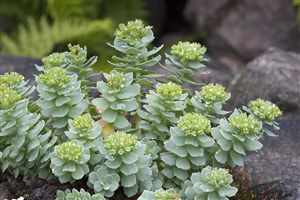Rhodiola (Rhodiola rosea), Arctic root
Main Facts about Rhodiola

Using Rhodiola
Rhodiola is considered an adaptogenic herb, meaning that it increases the body's overall resistance and helps to normalise bodily functions without stimulation burnout. It is famous for improving the body's responses to stress and boosting physical endurance. Studies of rhodiola in both humans and animals have indicated that it helps prevent fatigue, stress, and the damaging effects of oxygen deprivation (can be used to prevent altitude sickness). Studies also show that it enhances memorisation and concentration ability over prolonged periods and is effective for cardiac problems caused or aggravated by stress. Rhodiola both stimulates and protects the immune system.Rhodiola is a remedy for: Anxiety
Cooking with Rhodiola
Traditional healing methods have often incorporated rhodiola in the form of teas, tinctures, and tonics. The young succulent leaves of the herb, as well as the roots, shoots, and stems, are edible and can be cooked like spinach (leaves and shoots), consumed as a starchy vegetable (cooked roots), served in a raw, mixed salad (stems and leaves), made into a sauerkraut (leaves and shoots), prepared and eaten like asparagus (leaves and shoot). Some people find the slightly bitter taste not particularly palatable.How to grow Rhodiola
Rhodiola thrives in tundra-like areas, particularly on slopes, ridges, and cliffs. It can survive in somewhat moist environments, but it tends to do best in dry tundra where the soil has low moisture content.| Ramón |
Rooibos
|